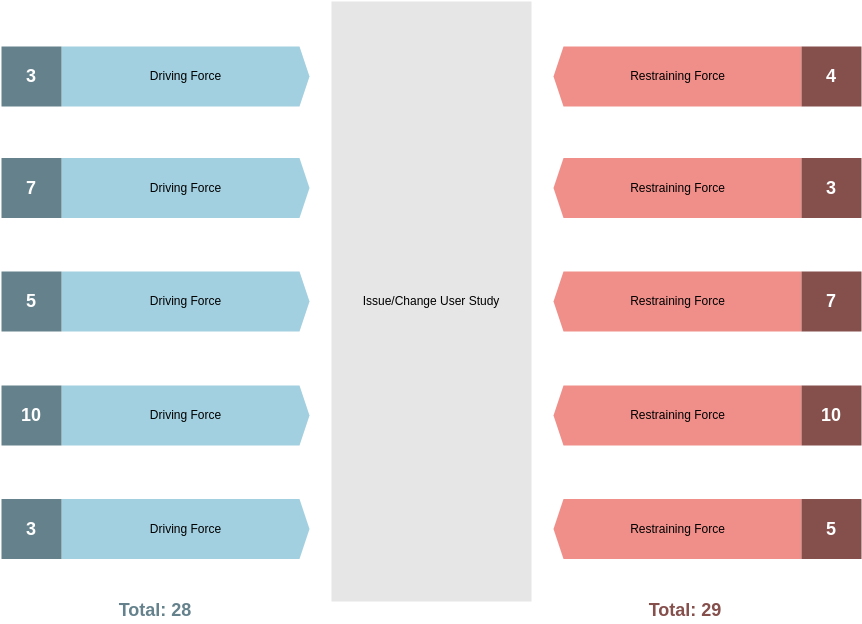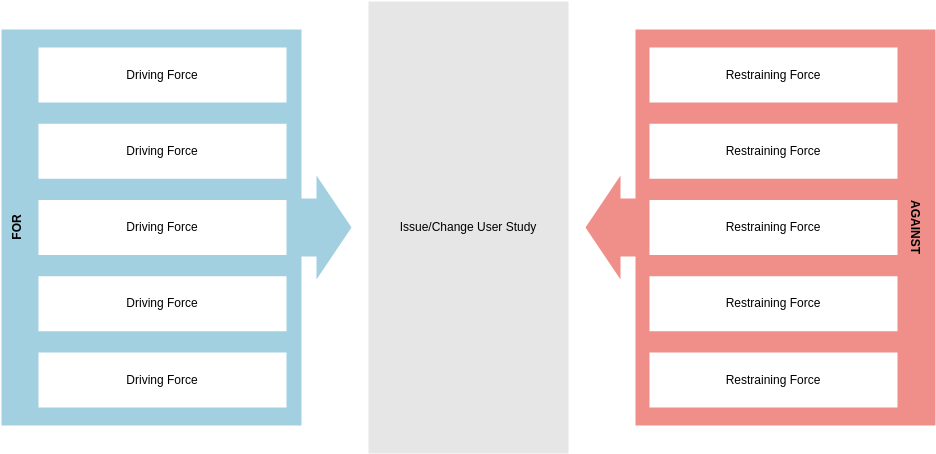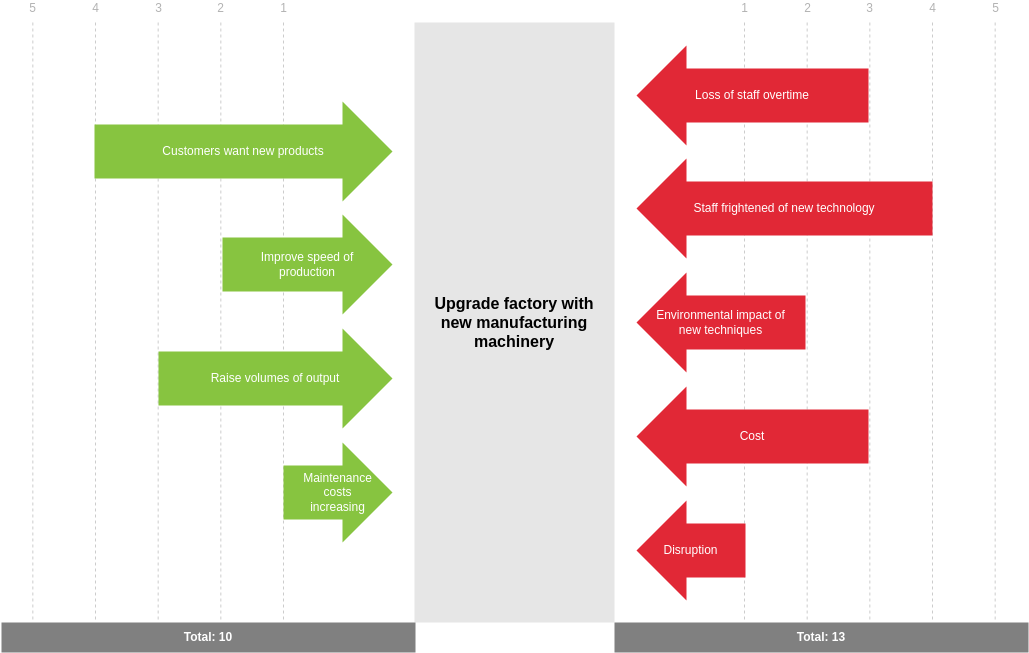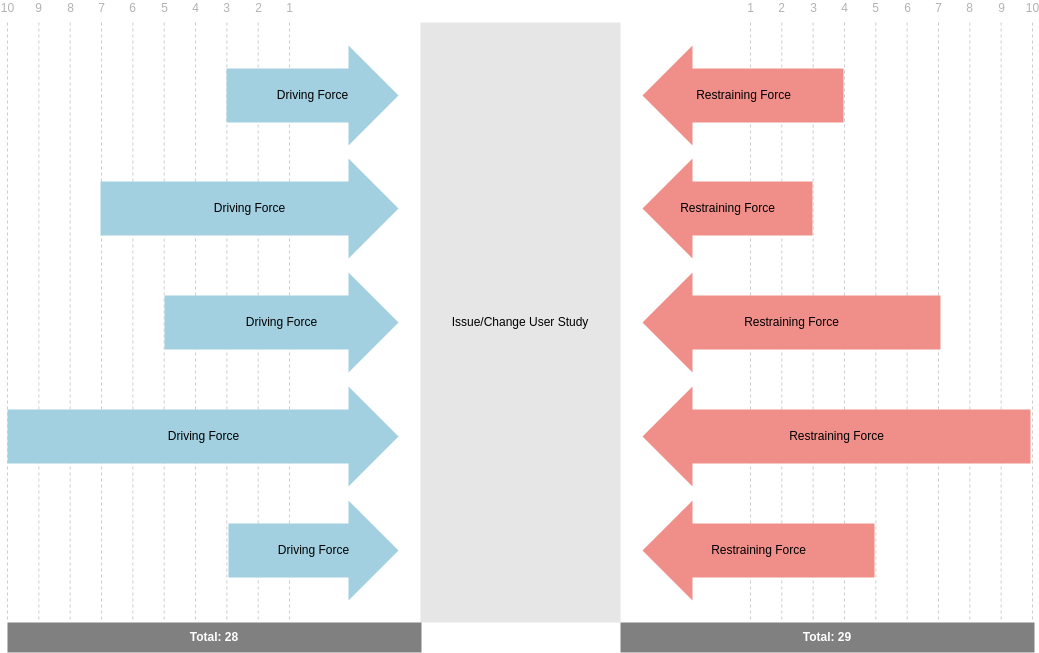What is Force Field Analysis?
Force Field Analysis is a foundational tool for root cause analysis that aids organizations in taking meaningful action once a root cause has been identified. Developed by psychologist Kurt Lewin in the 1940s, this technique operates on the premise that any situation results from a balance of forces that either promote or hinder change. By counteracting opposing forces or amplifying favorable ones, organizations can facilitate change by reinforcing positive aspects and diminishing negative ones.
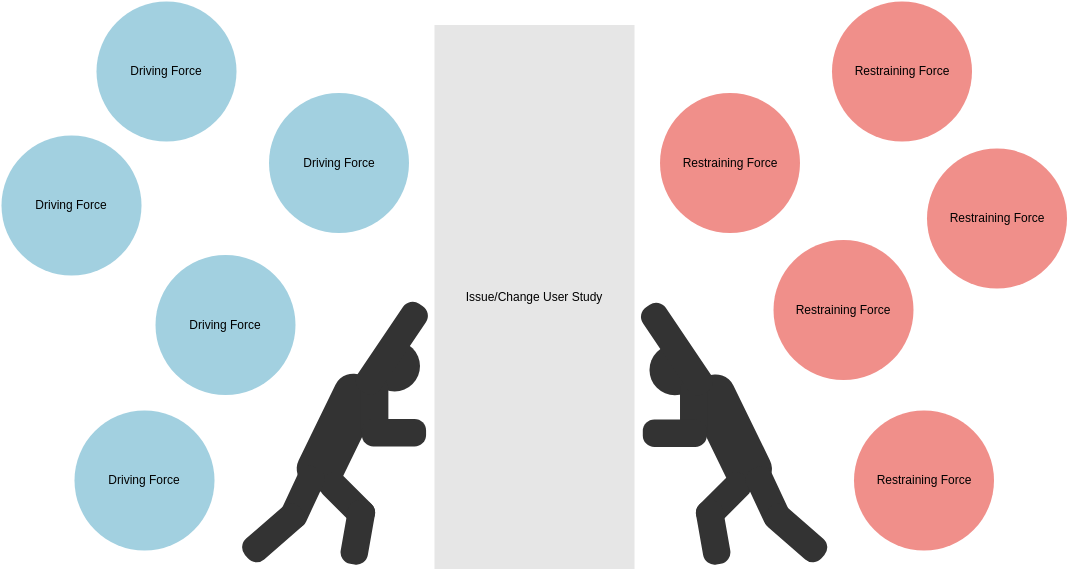
Key Features of Force Field Analysis
- Comparison of Positives and Negatives: It presents the advantages and disadvantages of a situation side by side, making them easily comparable.
- Comprehensive Consideration: It takes into account all relevant aspects of implementing desired changes.
- Encouragement of Agreement: The process fosters consensus on the relative importance of factors affecting the situation.
- Honest Reflection: It promotes genuine introspection regarding the underlying causes of a problem and its potential solutions.
Why Use Force Field Analysis?
1. Enhanced Decision-Making
By clearly outlining driving and restraining forces, organizations can make informed decisions about change initiatives.
2. Improved Communication
The visual nature of the analysis facilitates discussions among stakeholders, making it easier to communicate ideas and concerns.
3. Effective Change Management
By identifying both supportive and obstructive forces, organizations can devise targeted strategies to strengthen driving forces and address restraining ones.
4. Root Cause Identification
Force Field Analysis encourages a deeper understanding of the factors contributing to a problem, aiding in the identification of root causes.
When to Use Force Field Analysis?
1. Before Implementing Changes
Utilize Force Field Analysis when planning any significant organizational change, such as adopting new technologies or restructuring teams.
2. During Strategic Planning
Incorporate the analysis in strategic planning to evaluate the feasibility of proposed initiatives and identify potential obstacles.
3. When Facing Resistance
Use the analysis to understand and address resistance to change, ensuring that all concerns are considered.
How to Conduct Force Field Analysis
Step 1: Identify the Change
Clearly define the change you intend to implement.
Step 2: Brainstorm Forces
Gather your team to brainstorm all possible forces, both internal and external, that could impact the change. Identify factors that support and hinder the change.
Step 3: Assess Force Strength
Evaluate the strength of each identified force, considering how significantly it could impact the change process.
Step 4: Create a Force Field Diagram
Visualize the forces in a force field diagram, with arrows representing each force’s strength. The length of each arrow should be proportional to the strength of the force it represents.
Step 5: Strategize
For each force, especially the stronger ones, discuss strategies to increase the driving forces and reduce the restraining forces.
Force Field Analysis Examples
Here are some examples of Force Field Analysis across different contexts:
1. Implementing a New Software System
- Driving Forces:
- Increased efficiency and productivity.
- Improved data management and reporting capabilities.
- Support from management and IT department.
- Restraining Forces:
- Resistance from employees due to fear of change.
- Training requirements and learning curve.
- Potential disruptions to current workflows.
2. Organizational Restructuring
- Driving Forces:
- Need for improved communication and collaboration.
- Market demands requiring a more agile structure.
- Positive feedback from stakeholders about the proposed changes.
- Restraining Forces:
- Employee apprehension regarding job security.
- Established organizational culture resistant to change.
- Possible loss of productivity during the transition period.
3. Launching a New Product
- Driving Forces:
- Market research indicating high demand for the product.
- Strong brand reputation and customer loyalty.
- Availability of resources and funding for development.
- Restraining Forces:
- Competition from established products in the market.
- Concerns about production costs and pricing strategies.
- Potential regulatory hurdles or compliance issues.
4. Adopting Remote Work Policies
- Driving Forces:
- Increased employee satisfaction and work-life balance.
- Cost savings on office space.
- Access to a broader talent pool.
- Restraining Forces:
- Concerns about team cohesion and communication.
- Technology issues and cybersecurity risks.
- Resistance from managers accustomed to traditional oversight.
5. Health and Safety Initiatives in a Workplace
- Driving Forces:
- Legal requirements for safety compliance.
- Improved employee morale and productivity.
- Potential reductions in insurance costs.
- Restraining Forces:
- Resistance to new protocols from staff.
- Additional training and resource allocation needed.
- Possible initial costs for implementing safety measures.
6. Community Program Development
- Driving Forces:
- Community interest in improving local services.
- Support from local government and organizations.
- Availability of funding and resources.
- Restraining Forces:
- Lack of awareness or involvement from community members.
- Potential conflicts with existing programs or initiatives.
- Limited volunteer availability and commitment.
These examples illustrate how Force Field Analysis can be applied in various scenarios to understand the dynamics of change and develop strategies for successful implementation.
Conclusion
Force Field Analysis is a powerful tool that enables organizations to navigate the complexities of change effectively. By clearly identifying and visualizing the driving and restraining forces at play, organizations can make informed decisions that enhance their likelihood of success. This analytical approach not only fosters better communication and collaboration among stakeholders but also encourages a deeper understanding of the challenges and opportunities that accompany any change initiative.
Whether applied in technology adoption, organizational restructuring, or community development, Force Field Analysis provides a structured framework for evaluating the factors influencing change. By leveraging this tool, organizations can proactively address potential obstacles and reinforce supportive elements, ultimately leading to more successful outcomes and a smoother transition during the change process.
🌟 Transform Your Change Management with Visual Paradigm Online! 🌟
Are you looking to navigate the complexities of organizational change effectively? Look no further! Visual Paradigm Online is the ultimate tool for conducting Force Field Analysis—helping you visualize and strategize the driving and restraining forces that influence your initiatives.
Why Choose Visual Paradigm Online?
✅ User-Friendly Interface: Create professional-looking diagrams effortlessly with our intuitive design tools.
✅ Collaboration Made Easy: Work with your team in real-time, ensuring everyone is on the same page and contributing to the analysis.
✅ Customizable Templates: Get started quickly with customizable templates specifically designed for Force Field Analysis.
✅ Comprehensive Features: Utilize a wide range of diagramming tools to enhance your analysis, from brainstorming sessions to detailed presentations.
✅ Cloud-Based Convenience: Access your projects anytime, anywhere, ensuring flexibility and continuity in your change management efforts.
Take Your Change Initiatives to the Next Level!
With Visual Paradigm Online, you can easily identify the forces at play in your organization, make informed decisions, and drive successful change. Whether you’re implementing a new software system, restructuring your teams, or launching a new product, our platform has you covered.
👉 Start your free trial today and experience the power of Visual Paradigm Online!
Let’s make your change management process smoother and more effective together! 🌟
Create Force Field Analysis Diagram with Visual Paradigm Online
